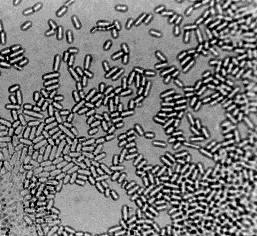
This Page is Created for an Undergraduate Molecular Biology Course at Davidson College
It will not be in complete form until February 20, 2002

Picture provided by The Forsburg Lab pombe Pages
http://pingu.salk.edu/~forsburg/pictures.html
http://pingu.salk.edu/%7Eforsburg/lab.html
This experiment, conducted by the Molecular Biology class at Davidson College, aims to clone the five IDH (isocitrate dehydrogenase) genes of the yeast Saccharomyces cerevisiae. We further aim to functionally express all five genes in a prokaryote. The five genes (IDH1, IDH2, IDP1, IDP2, and IDP3) are amplified via PCR using primers designed by students. These PCR gene products are inserted into the pQE-30 UA expression vector. These plasmids are then taken up by E. coli. cells. We must then test our E. coli. colonies' plasmids to be sure that the inserts are in the correct orientation. Once we have selected cells containing our desired plasmid we will test whether or not the IDH proteins are being expressed. We will further test the proteins via an enzyme assay to determine whether or not our cloned genes are functioning properly. Chris Norbet and I work in the Thursday afternoon lab and are cloning the IDH1 gene.
IDH genes provide a control point in the citric acid cycle (Purves et al., 1998). IDH1 and IDH2 are subunits of the NAD(+)-specific isocitrate dehydrogenase. IDH2 contains the catalytic site, and IDH1 contributes regulatory properties. The two subunits interact with one another to affect the binding of isocitrate (Panisko et al., 2001). IDP1, IDP2, and IDP3 are NADP(+)-specific isocitrate dehydrogenses. IDP1 is the cytosolic isozyme, IDP2 is mitochondrial isozyme (Loftus et al., 1994). IDP3 is the peroxisomal isozyme required for beta-oxidation of unsaturated fatty acids (Henke et al., 1998).
More papers to view on IDH genes (available through PubMed):
Haselbeck,R.J. and McAlister-Henn,L. 1991. Isolation nucleotide sequence, and disruption of the Saccharomyces cerevisiae gene encoding mitochondrial NADP(H)-specific isocitrate dehydrogenase. J. Biol. Chem. 266: 2339-2345
Haselbeck RJ, McAlister-Henn L 1993. Function and expression of yeast mitochondrial NAD- and NADP-specific isocitrate dehydrogenases. J Biol Chem. 268(16):12116-22.
Below is information pertaining to the IDH genes as well as the experiments conducted in order to clone all five genes. This web page is intended to present important information about each IDH gene, display PCR primer design, and to describe an experiment that will test insert orientation. To learn more about specific lab protocols please click one of the Lab Experiment links below.
Purves, W.K., Orians, G.H., Heller, H.C., Sadava, D. Life: The Science of Biology. Massachusetts: Sinauer Associates, Inc., 1998.
Panisko EA, McAlister-Henn L. 2001. Subunit interactions of yeast NAD+-specific isocitrate dehydrogenase. J Biol Chem. 276(2):1204-10
Loftus TM, Hall LV, Anderson SL, McAlister-Henn L. 1994. Isolation, characterization, and disruption of the yeast gene encoding cytosolic NADP-specific isocitrate dehydrogenase. Biochemistry. 33(32):9661-7
Henke B, Girzalsky W, Berteaux-Lecellier V, Erdmann R. 1998. IDP3 encodes a peroxisomal NADP-dependent isocitrate dehydrogenase required for the beta-oxidation of unsaturated fatty acids. J Biol Chem. 273(6):3702-11
Visit Davidson Biology on the Web
Molecular Biology Home Page
Contact Kevin James with any questions or comments